ACA Simulation (CASA 3.3): Difference between revisions
m Estarr moved page ACA Simulation to ACA Simulation (CASA 3.3) |
|||
| (20 intermediate revisions by 3 users not shown) | |||
| Line 3: | Line 3: | ||
To create a script of the Python code on this page see [[Extracting scripts from these tutorials]]. | To create a script of the Python code on this page see [[Extracting scripts from these tutorials]]. | ||
__NOTOC__ | |||
== ALMA 12m + ACA + Total Power == | == ALMA 12m + ACA + Total Power == | ||
| Line 9: | Line 9: | ||
other combinations, can be simulated by running sim_observe for each, and then combining the | other combinations, can be simulated by running sim_observe for each, and then combining the | ||
Measurement Sets to run sim_analyze. Total power observations can be simulated either in an independent run of sim_observe, or along with an interferometric simulation. Note that if you simulate total power and an interferometric observation simultaneously with sim_observe, they must have the same set of pointing centers and the same integration and total time, which is probably not realistic. (For example it is generally recommended to observe a larger area by 1/2 primary beam in total power mode to combine with a 12m ALMA mosaic). | Measurement Sets to run sim_analyze. Total power observations can be simulated either in an independent run of sim_observe, or along with an interferometric simulation. Note that if you simulate total power and an interferometric observation simultaneously with sim_observe, they must have the same set of pointing centers and the same integration and total time, which is probably not realistic. (For example it is generally recommended to observe a larger area by 1/2 primary beam in total power mode to combine with a 12m ALMA mosaic). | ||
=====Set sim_observe as current task===== | =====Set sim_observe as current task===== | ||
| Line 23: | Line 19: | ||
</source> | </source> | ||
=====Specify sky model image===== | =====Specify sky model image===== | ||
We'll use an Halpha image of M51 as an example model sky. Download [[File: | We'll use an Halpha image of M51 as an example model sky. Download [[File:M51ha.fits.txt]] and place in your working directory, or use the curl command in the script. | ||
sim_observe will make a copy m51c/m51c.skymodel, and not modify your input image. | sim_observe will make a copy m51c/m51c.skymodel, and not modify your input image. | ||
<source lang="python"> | <source lang="python"> | ||
# Model sky = Halpha image of M51 | # Model sky = Halpha image of M51 | ||
skymodel = " | os.system('curl http://casaguides.nrao.edu/images/3/3f/M51ha.fits.txt -f -o M51ha.fits.txt') | ||
skymodel = "M51ha.fits.txt" | |||
</source> | </source> | ||
Although the image has a world coordinate system, we want to override most of the parameters. | Although the image has a world coordinate system, we want to override most of the parameters. | ||
| Line 52: | Line 49: | ||
We'll begin with the 12m ALMA array observation, and have sim_observe calculate a hexagonal mosaic of pointings. | We'll begin with the 12m ALMA array observation, and have sim_observe calculate a hexagonal mosaic of pointings. | ||
The default interface for sim_observe provides an integration parameter, which is the dwell time at each mosaic pointing -- we'll set that to 10s. A real observation would integrate a scan of ~5 min at each mosaic pointing; we could set integration="5min" but then for data volume and speed, sim_observe would only generate one measurement per 5min scan. While thermal noise levels would be scaled correctly, corruption of the data with a phase screen | The default interface for sim_observe provides an integration parameter, which is the dwell time at each mosaic pointing -- we'll set that to 10s. A real observation would integrate a scan of ~5 min at each mosaic pointing; we could set integration="5min" but then for data volume and speed, sim_observe would only generate one measurement per 5min scan. While thermal noise levels would be scaled correctly, corruption of the data with a phase screen, or the details of uv coverage, would not be realistic. Rotating through the mosaic more rapidly than a real simulation will result in more representative uv coverage. If you wish to simulate the more realistic case such as 5 min scans with 5s integrations, please see [[Complex pointingtable]] for a guide to doing that with sim_observe (Its not hard, it just takes two calls to the task instead of one). | ||
<source lang="python"> | <source lang="python"> | ||
| Line 71: | Line 68: | ||
</source> | </source> | ||
run sim_observe, displaying graphics to screen and file | run sim_observe, displaying graphics to screen and file (files can be found in the project directory, e.g. m51c) | ||
<source lang="python"> | <source lang="python"> | ||
| Line 77: | Line 74: | ||
go | go | ||
</source> | </source> | ||
---- | |||
====Simulate 12m total power observation==== | ====Simulate 12m total power observation==== | ||
| Line 110: | Line 110: | ||
go | go | ||
</source> | </source> | ||
---- | |||
====Simulate 7m ACA observation==== | ====Simulate 7m ACA observation==== | ||
[[Image:M51c.aca.i.skymodel.png|thumb|hexagonal map overplotted on sky model]] | |||
Next we'll add an ACA mosaic, with its larger primary beam. | Next we'll add an ACA mosaic, with its larger primary beam. | ||
| Line 138: | Line 143: | ||
---- | |||
====Deconvolve the visibilities back into an image==== | ====Deconvolve the visibilities back into an image==== | ||
| Line 153: | Line 159: | ||
====First image total power and ACA with total power as a model==== | ====First image total power and ACA with total power as a model==== | ||
[[Image:M51c.aca.i.analysis.png|thumb|Total power combined (with relatively low weight) with ACA]] | |||
<source lang="python"> | <source lang="python"> | ||
| Line 166: | Line 173: | ||
go() | go() | ||
</source> | </source> | ||
====Next add the 12m interferometric data==== | ====Next add the 12m interferometric data==== | ||
[[Image:M51c.ALMA_0.5arcsec.analysis.png|thumb|TP+ACA combined (with relatively low weight) with 12m ALMA]] | |||
Here we explicitly have to set the modelimage to the previous output. | Here we explicitly have to set the modelimage to the previous output. | ||
| Line 175: | Line 185: | ||
default("sim_analyze") | default("sim_analyze") | ||
project = "m51c" | project = "m51c" | ||
vis = 'project. | vis = '$project.ALMA_0.5arcsec.ms' | ||
imsize = [512,512] | imsize = [512,512] | ||
cell = '0. | cell = '0.1arcsec' | ||
modelimage = "$project.aca.i.image" | modelimage = "$project.aca.i.image" | ||
analyze = True | analyze = True | ||
showpsf = False | |||
showresidual = False | showresidual = False | ||
showconvolved = True | showconvolved = True | ||
| Line 185: | Line 196: | ||
</source> | </source> | ||
{{Simulations Intro}} | {{Simulations Intro}} | ||
Latest revision as of 22:51, 26 March 2024
↵ Simulating Observations in CASA
To create a script of the Python code on this page see Extracting scripts from these tutorials.
ALMA 12m + ACA + Total Power
Multiple configurations, or an observation in one 12m configuration plus one ACA observation, or other combinations, can be simulated by running sim_observe for each, and then combining the Measurement Sets to run sim_analyze. Total power observations can be simulated either in an independent run of sim_observe, or along with an interferometric simulation. Note that if you simulate total power and an interferometric observation simultaneously with sim_observe, they must have the same set of pointing centers and the same integration and total time, which is probably not realistic. (For example it is generally recommended to observe a larger area by 1/2 primary beam in total power mode to combine with a 12m ALMA mosaic).
Set sim_observe as current task
Reset all parameters to default, and then set the project name to m51c
# Set sim_observe to default parameters
default("sim_observe")
# Our project name will be m51c, and all simulation products will be placed in a subdirectory m51c/
project="m51c"
Specify sky model image
We'll use an Halpha image of M51 as an example model sky. Download File:M51ha.fits.txt and place in your working directory, or use the curl command in the script.
sim_observe will make a copy m51c/m51c.skymodel, and not modify your input image.
# Model sky = Halpha image of M51
os.system('curl http://casaguides.nrao.edu/images/3/3f/M51ha.fits.txt -f -o M51ha.fits.txt')
skymodel = "M51ha.fits.txt"
Although the image has a world coordinate system, we want to override most of the parameters.
- We'll place the source in the southern hemisphere with the indirection parameter,
- set the pixel size to 0.1arcsec, effectively moving the galaxy further away (M51 itself would require a quite large mosaic, and in any case we need for the input model pixels to be significantly smaller than the synthesized beam that we'll be simulating, or else we won't be learning anything)
- consistent with simulating a more distant source, we'll set the peak brightness to 0.004 Jy/pixel
- set the frequency to 330GHz, and since its a 2D image we'll set the single "channel" width to be 50MHz, and peak brightness of 0.004 Jy/pixel - parameters plausible for observing an emission line in a galaxy.
# Set model image parameters:
indirection="B1950 23h59m59.96s -34d59m59.50s"
incell="0.1arcsec"
inbright="0.004"
incenter="330.076GHz"
inwidth="50MHz"
Simulate 12m interferometric observation
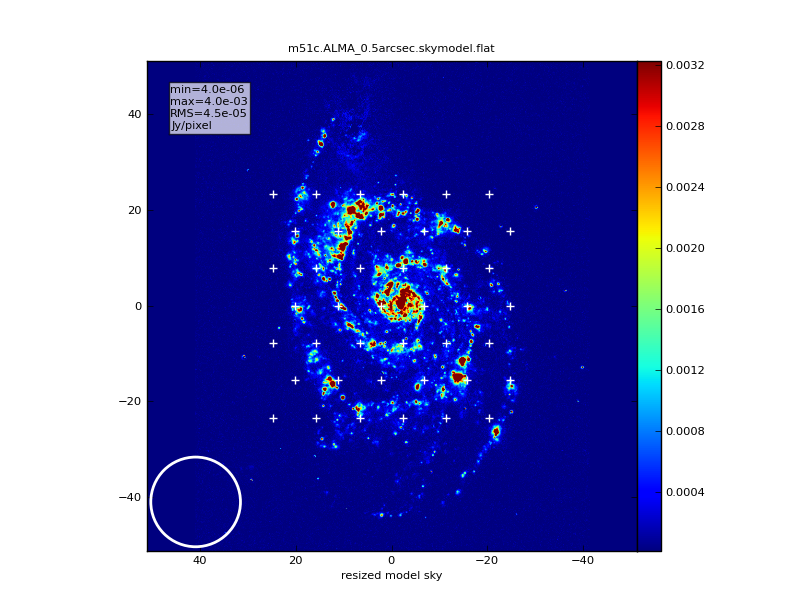
We'll begin with the 12m ALMA array observation, and have sim_observe calculate a hexagonal mosaic of pointings.
The default interface for sim_observe provides an integration parameter, which is the dwell time at each mosaic pointing -- we'll set that to 10s. A real observation would integrate a scan of ~5 min at each mosaic pointing; we could set integration="5min" but then for data volume and speed, sim_observe would only generate one measurement per 5min scan. While thermal noise levels would be scaled correctly, corruption of the data with a phase screen, or the details of uv coverage, would not be realistic. Rotating through the mosaic more rapidly than a real simulation will result in more representative uv coverage. If you wish to simulate the more realistic case such as 5 min scans with 5s integrations, please see Complex pointingtable for a guide to doing that with sim_observe (Its not hard, it just takes two calls to the task instead of one).
# have sim_observe calculate mosaic pointing locations:
setpointings = True
integration = "10s"
mapsize = "1arcmin"
maptype = "hex"
pointingspacing = "9arcsec" # this could also be specified in units of the primary beam e.g. "0.5PB"
Calculate Visibilities
sim_observe can determine what array configuration to use, if you provide a desired resolution or synthesized beam size.
observe = True
antennalist = "ALMA;0.5arcsec"
totaltime = "3600s"
run sim_observe, displaying graphics to screen and file (files can be found in the project directory, e.g. m51c)
graphics = "both"
go
Simulate 12m total power observation
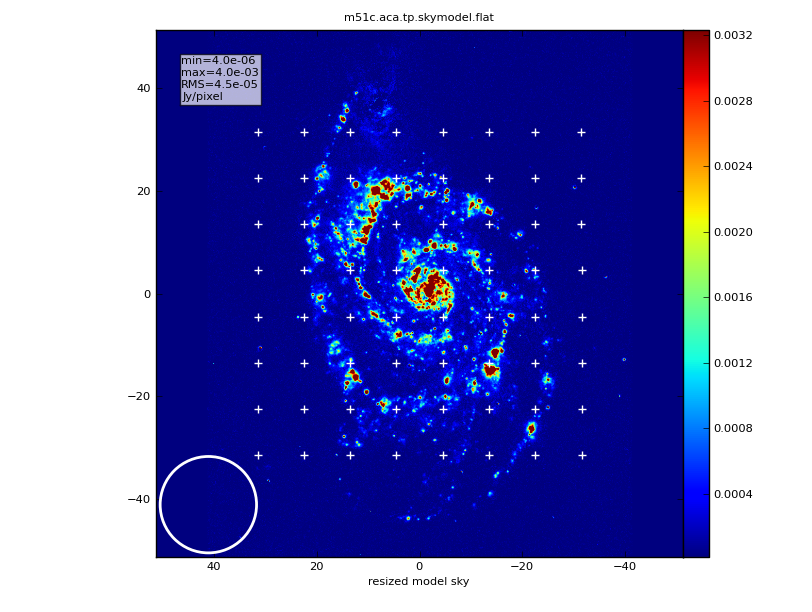
Next we'll simulate a total power raster map of the same area, but on a more realistic square grid. CASA simulation tools can not simulate true on-the-fly mapping (with smearing on timescales smaller than an integration time), but a square grid with a short integration time will provide a very accurate approximation.
By virtue of CASA's global parameters, we already have project and image world coordinate system parameters set correctly.
We need to change the pointing calculation to make it square and a bit larger than the interferometric map.
integration = "10s"
mapsize = "1.3arcmin"
maptype = "square"
We'll observe on a different day (this doesn't really matter, but if you choose to simulate two different 12m ALMA configurations and combine them, if they're simulated on the same day with the same antenna names you will have issues concatenating the datasets, so its a good habit to change the day)
sdantlist = "aca.tp.cfg"
sdant = 0
refdate = "2012/12/01"
# SET interferometric antennalist to default, or else we'll redo the interferometric simulation too
antennalist = ""
totaltime = "2h"
run sim_observe, displaying graphics to screen and file
go
Simulate 7m ACA observation
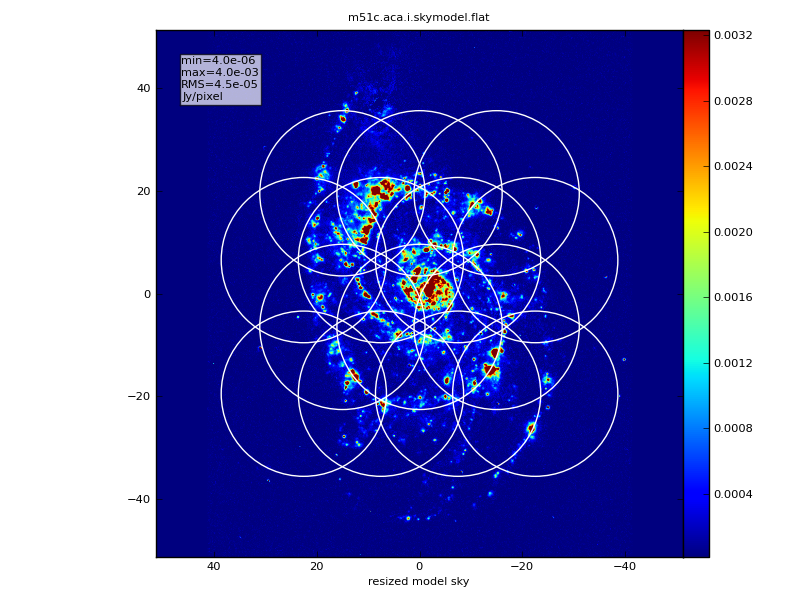
Next we'll add an ACA mosaic, with its larger primary beam.
integration = "10s"
mapsize = "1arcmin"
maptype = "hex"
pointingspacing = "15arcsec"
We can specify an integral number of times to repeat the mosaic by setting totaltime to an integer string without units.
# remember to set this back to empty
sdantlist = ""
refdate = "2012/12/02"
antennalist = "aca.i.cfg"
totaltime = "3"
run sim_observe, displaying graphics to screen and file
go
Deconvolve the visibilities back into an image
We use sim_analyze to take the three measurement sets and create a single image.
There are many ways to do this, and the project is NOT making any recommendation yet at this time about what is optimal. Please discuss with your ARC contact scientist if you have ALMA data now, or wait for additional recommendations to be posted here over time.
- We will use the total power image as a model when deconvolving the ACA image, and then use the result as a model when deconvolving the 12m interferometric image. This tends to give low weight to the large spatial scales, but is simple to illustrate.
- Improved results would result if one used multiscale clean, in the clean task (again using the lower resolution image as a model when deconvolving the higher resolution one)
- An alternative would be to create each image independently, and then use the CASA feather task to combine them entirely in the image plane.
sim_analyze, if given a total power and interferometric measurement set, will automatically create the total power image, then use it as a model and deconvolve the interferometric image. It is not recommended to do both interferometric images simultaneously.
First image total power and ACA with total power as a model
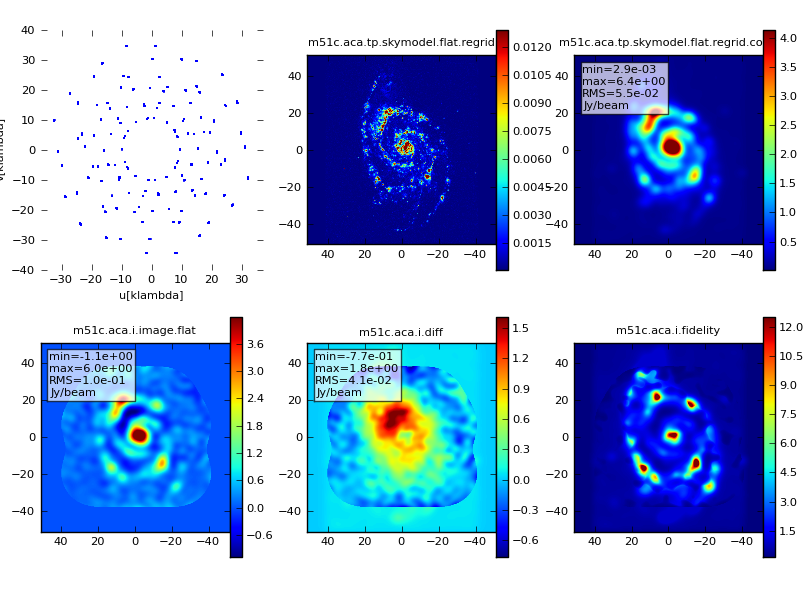
default("sim_analyze")
project = "m51c"
vis = '$project.aca.i.ms,$project.aca.tp.sd.ms'
imsize = [512,512]
cell = '0.2arcsec'
analyze = True
showpsf = False
showresidual = False
showconvolved = True
go()
Next add the 12m interferometric data
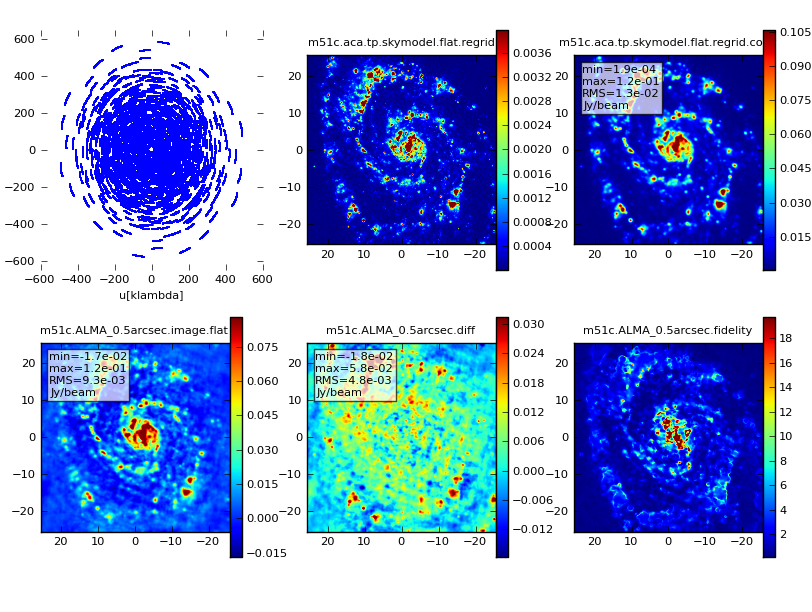
Here we explicitly have to set the modelimage to the previous output.
default("sim_analyze")
project = "m51c"
vis = '$project.ALMA_0.5arcsec.ms'
imsize = [512,512]
cell = '0.1arcsec'
modelimage = "$project.aca.i.image"
analyze = True
showpsf = False
showresidual = False
showconvolved = True
go()